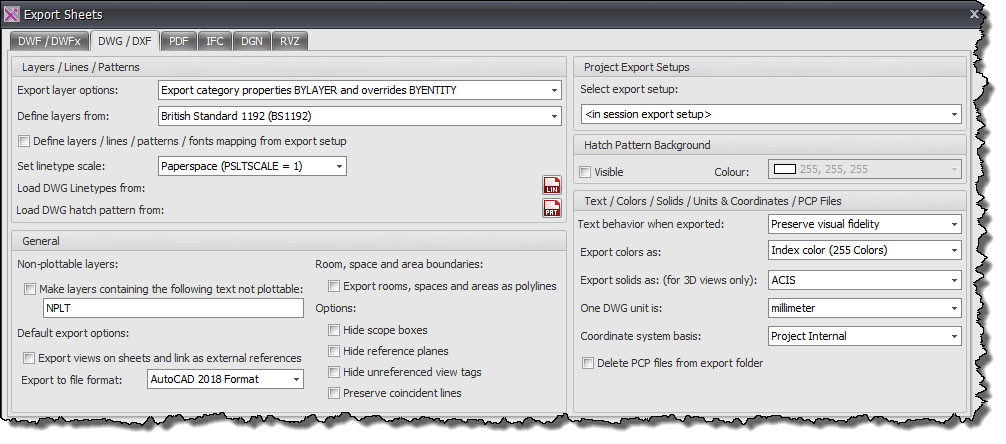You can use this export option when needing to generate Autocad .dwg files from your Revit Project.
Firstly select the required Revit Sheets or Revit Views to be exported from the Xporter Pro main interface and then click the Export button from the ribbon.
The top half of the Dialog box contain the specific settings and options for the resulting DWG / DXF files as shown by the below image.
- Export Layer Options – from the drop down there are three options from which to choose. Export Category properties BYLAYER and overrides BYENTITY, Export all properties BYLAYER, do not export overrides, Export all properties BYLAYER, create new layers for overrides.
- Define layers from – select from the drop down one of the predefined layer export standards (American Institute of Architects, ISO standard 13567, Singapore Standard 83, British Standard 1192) or select your own company customized layer standard export file if preferred.
- Set Linetype Scale – select from the drop down the preferred option (Scaled linetype definitions, Modelspace (PSLTSCALE=0), Paperspace (PSLTSCALE = 1)).
- Load DWG Linetypes from – specify the default linetype file to be used for exporting (typically either acad.lin or acadiso.lin).
- Load DWG hatch pattern from – specify the default hatch pattern file to be used for exporting (typically either acad.pat or acadiso.pat).
- Hatch Pattern Background – Either leave Hatch pattern background transparent or you can make it visible and select a colour.
- Text treatment during export – from the drop down choose how text formatting is handled when exporting from either Preserve visual fidelity or Preserve editability.
- Export colours as – From the drop down select either Index colour or True Colour
- Export solids as – From the drop down select either ACIS Solids or Polymesh. These settings are relevant to 3D views only.
- One DWG unit is – From the drop down select the required unit of measure for exporting.
- Coordinate system basis – From the drop down select either Shared or Project Internal to determine the coordinate base system used for exporting.
- Non plotable layers – you can use non plotable layers if required when exporting by checking the box and then adding the ‘text’ contained in layer names to be excluded from plotting.
- Default Export options – Choose the required DWG export file format to be used (eg:2018, 2013, 2010 etc). If required views on sheets can be treated as Xrefs and linked when exporting by checking the box to Xref views on sheets and link as external references
- Room and area boundaries – these items can be exported as polylines if required by checking the box.
- Options – these items are optional when exporting if you want to hide scope boxes, reference planes, and unreferenced view tags.
The lower portion of the Dialog box determines the File naming, export location file format settings and file upload settings for the exported files as shown by below example.
General Tab
- Folder Name Format panel – provide the means to define your Export folder output location and naming convention. Use the Format codes list to create the desired combination for the folder name or use the browse button to navigate to an existing folder location. If you want to use the same output folder for all file types then tick the checkbox below.
- File Naming Format – provide the means to determine your file naming convention. Use the Format codes list to create the desired combination for the file name template (a sample preview is given as a guide). If you want to use the same file naming syntax for all file format types then tick the checkbox below.
- Date Format – Use the date format options to select the required date format and date separator.
- Export Formats Panel – is where you select the required output formats by checking the required boxes
- Invalid Characters – if your file naming involves invalid characters tick the box for Xporter Pro to check and it will replace with the value entered such as a hyphen, dot, or underscore.
- Publish Panel – if you want the resulting exported files to be automatically uploaded to an FTP or FileShare site then tick the box and configure the FTP settings on the FTP tab etc.
- Create CSV Transmittal panel – provides the means to generate a CSV file to be used for aconex uploads. Click the Config button to configure which Revit parameters you want to use as Export parameters / columns in the resulting CSV file. Note that Xporter Pro will not actually perform the aconex upload.
- Export Configuration Settings panel – provides the means for you to save your selected export configuration settings to an .xml including folder and file naming conventions so that you can load the .xml file back again at a later date with all the settings.
FTP Tab
To find out more about the FTP tab for automatic uploads click here
Citrix ShareFile Tab
To find out more about the Citrix ShareFile tab for automatic uploads click here



